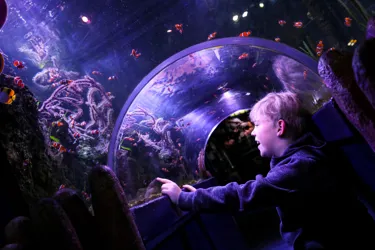A to Z
- Sunday 21st May 2017

Can you name animals from A to Z?
A is for…
Anthia
Anthias have the ability to change their sex. The dominant female of the group will change her sex to male if there is no male present.
B is for…
Big-Bellied Seahorse
Big-Bellied Seahorses, like other species of seahorse, have eyes that can move independently of each other!
C is for…
Clownfish
All Clownfish are born as boys!
D is for…
Dogfish
Dogfish are actually a type of shark, and our lesser spotted dogfish are native to the UK!
E is for…
Ephyra
Baby Jellyfish are known as ephyra. They form the gap between the polyp and medusa stages of the jellyfish lifecycle.
F is for…
Foxface rabbitfish
This species possesses sharp, venomous spines running across the top and bottom of their body which are capable of inflicting a nasty sting!
G is for…
Gentoo Penguin
Gentoo Penguins are the fastest swimming species of penguin, capable of reaching up to 22mph!
H is for…
Hermit Crab
As Hermit Crabs grow they abandon their shells in favour of new larger ones!
I is for…
(Carettochelys) insculpta – Pig-Nosed Soft Shell Turtle
The Pig-Nosed Soft Shell Turtle’s snout has sensory receptors which help it to locate prey in the murky water!
J is for…
Jellyfish
There are approximately 2000 known species of Jellyfish in the world, but only around 70 of these are typically harmful to humans!
K is for…
(Pterapogon) kauderni – Banggai Cardinalfish
The male Banggai Cardinalfish swallows the eggs released by the female and broods them in a special pouch inside his mouth!
L is for…
Lumpsucker
The Lumpsucker gets its name from its ability to suck onto rocks and stick there, even in strong tidal conditions!
M is for…
Multi-Banded Pipefish
Pipefish are in the same family as the seahorses!
N is for…
Nurse Shark
The Nurse Shark is one of the few species that is able to sit at the bottom of the sea floor as it is able to self-pump water over its gills to continue breathing!
O is for…
Octopus
The only hard part of an Octopus is its beak, meaning that if this can fit through a gap, then so can the whole Octopus!
P is for…
Piranha
Piranhas have a ferocious reputation due to their sharp teeth, strong jaws and participation in feeding frenzy, but in reality they are much calmer, eat only a small amount of food and are not what people expect!
Q is for…
(Entacmea) quadricolor – Bubble Tip Anemone
Anemones provide homes for clownfish who hide in there for protection from predators!
R is for…
Razorfish
Razorfish look as if they are swimming upside-down with their tails up in the air and heads down towards the sea bed. This adaptation is perfect for hiding amongst sea urchin spines!
S is for…
Sand Tiger Shark
Sand Tiger Sharks have been known to take gulps of air from the surface of the water to help their buoyancy when they hunt for prey!
T is for…
Turtle
The Green Sea Turtles name comes from the colour of their fat, not the colour of their shell.
U is for…
Undulate Ray
Undulate Rays lay eggs known as Mermaids Purses, which look like leathery pouches!
V is for…
(Anisotremus) virginicus – Pork Fish
Pork Fish are often referred to as grunts, due to the grunting noise they make by grinding their teeth together!
W is for…
Wolffish
Wolffish use their fang-like teeth and crushing molars to crunch through shells of shellfish and crustaceans!
X is for…
(Zebrasoma) xanthurum – Purple Tang
Tangs have a single spine or ‘scalpel’ on each side of their body, by the base of their tail. This is used for defence or dominance!
Y is for…
Yellow Tang
Although the Yellow Tang is thought of as endemic to Hawaii, its distribution has extended and is now much larger!
Z is for…
Zebra Moray Eel
Moray Eels have an incredible way of hunting. They have a second jaw that rests deeper in their bodies which shoot out into their main jaws when trapping prey!